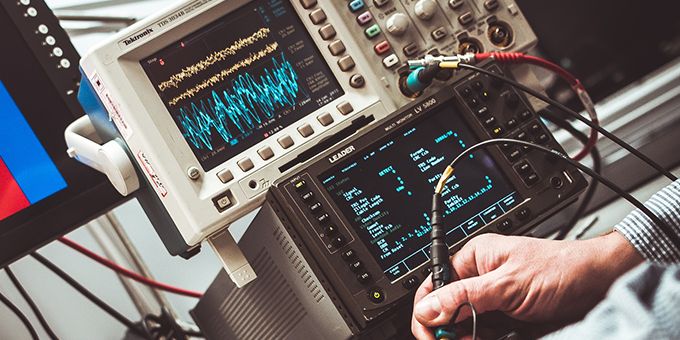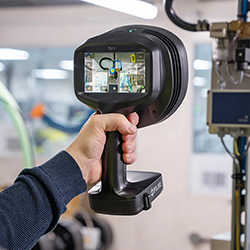Mechatronics and industrial automation are two fields that overlap to some extent. But they have their differences, too. Here's a definition of each, plus how they benefit the manufacturing sector.
 How Are Mechatronics and Industrial Automation Different?
How Are Mechatronics and Industrial Automation Different?

Megan Ray Nichols | Schooled by Science
Mechatronics and industrial automation are two fields that overlap to some extent. But they have their differences, too. Here's a definition of each, plus how they benefit the manufacturing sector.
What Is Mechatronics?
Mechatronics is the convergence of mechanical engineering with electronics and electrical circuits, plus control and software engineering. Some people also add telecommunications to the fields that mechatronics encompasses.
Jim Devaprasad, a professor in the engineering and technology school at Lake Superior State University, broadened his mechatronics definition to include a manufacturing element. He also pointed out that mechatronics is what people once termed "systems engineering."
Although mechatronics began as the study of mechanical and electrical interactions, it has since changed. Mechatronics now involves studying how those electromechanical happenings affect other equipment. Some of that equipment relates to industrial automation, such as robots.
Professionals who study mechatronics often build the automated systems that manufacturing plants increasingly use. But a mechatronics system is not necessarily specific to industrial automation. For example, if a digital thermostat has a feedback sensor and a microprocessor, it's a mechatronics system. But that thermostat may not have any automated elements — and digital thermostats are not solely associated with industrial automation.
During the design process of a system or product, mechatronics professionals prioritize system-based thinking and interdisciplinary problem-solving. System-based thinking means that a person takes a holistic view to understand how each part relates to another and affects the system as a whole. The interdisciplinary aspect indicates that people who specialize in mechatronics can anticipate working with people from different fields to collaborate for the best results.
The Benefits of Mechatronics for Manufacturing
Mechatronics design takes customer or project specifications into account. It also looks for cross-functional issues that could crop up unless dealt with in the early stages. Moreover, mechatronics seeks to optimize high functionality and efficiency, two qualities that promote progress in manufacturing as well as other industries.
A partnership between Siemens and Festo Didactic aims to directly address the manufacturing skills shortage with mechatronics training. Students receive training in a simulated smart factory environment, which equips them for advanced manufacturing careers after they get certified through the program.
What Is Industrial Automation?
Industrial automation focuses on using technology to achieve tasks with minimal human intervention. People often bring up a four-tier hierarchy when discussing the topic.
At the bottom is the field level, which is comprised of sensors and actuators. The sensors collect data on things like temperature and speed. Conversely, the actuators receive electrical or pneumatic signals and convert them into actions.
The second segment is the control level, which contains various automation controls. Programmable logic controllers receive frequent usage in industrial settings and are examples of the kinds of controls found at this level. The controls allow operators to program a machine to perform certain functions and automate how it operates.
The third tier is the supervisory level. It contains equipment such as human-machine interfaces and gadgets that can set production targets or trigger startup and shutdown commands.
The enterprise level is the top part of the hierarchy. It manages the entire automation system but relates more to the commercial aspects, like sales and orders, than the technical things going on in the background.
The Benefits of Industrial Automation for Manufacturing
Industrial automation machines frequently have mechanical and electrical components working together. This is where the lines between mechatronics and industrial automation blur somewhat. However, as clarified earlier, some mechatronic devices have no automated components. Some schools offer courses that expose students to both mechatronics and industrial automation.
Industrial automation is a primary component of the fourth industrial revolution. Advancements center on combining computers with physical equipment to achieve the ideal results. Thus, the companies that invest in industrial automation often seek benefits such as increased output and improved scalability.
Since industrial automation minimizes or eliminates human involvement, it can cut down on issues related to fatigue or user error. Some systems can respond to changes and self-adjust as necessary. Others let operators avoid downtime by alerting people of the need for maintenance.
As the demands on manufacturing plants rise, industrial automation will enjoy a growing relevance. Moreover, it will evolve as technologies improve or get tweaked for better suitability in manufacturing.
Two Concepts With Significant Overlap
As this overview shows, there are not always clear-cut distinctions between mechatronics and industrial automation. Mechatronics specialists often work on projects related to industrial automation but tackle other projects, too. And while mechatronics is an umbrella term covering many disciplines, industrial automation is more tightly focused. It seeks to let machines perform tasks that began as solely manual duties.
However, despite the differences between these fields, both of them can positively impact manufacturing. As the sector gets ever more advanced and dependent on specialized machines, the contributions of mechatronics and industrial automation experts will remain indispensable for the foreseeable future.
The content & opinions in this article are the author’s and do not necessarily represent the views of ManufacturingTomorrow
Comments (0)
This post does not have any comments. Be the first to leave a comment below.
Featured Product

